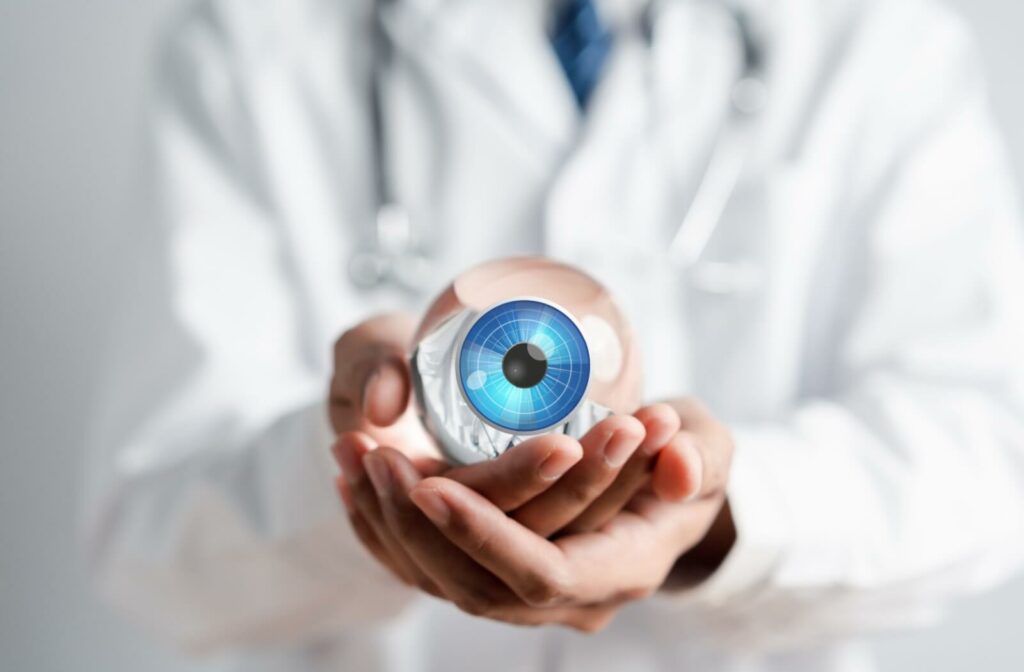Routine eye exams are important for maintaining optimal eye health and vision. Factors like age, family history, and risk factors for developing eye conditions impact how often you should have an eye exam.
It’s recommended that children between 6 months and 18 years, seniors 65 and older, and contact lens wearers have an annual eye exam.
Adults between 19 and 64 should have an eye exam once every two years and individuals with type 1 or type 2 diabetes should have a diabetic eye exam once a year.
Importance of Eye Exams
Eye exams aren’t just about correcting vision with glasses or contact lenses. They go beyond vision correction. They’re important for detecting changes in your vision and assessing your overall ocular health.
Regular eye exams can identify ocular concerns that may not show initial symptoms, such as cataracts, glaucoma, diabetic retinopathy, or macular degeneration. Additionally, eyes can show signs of general health issues before they manifest symptoms, such as diabetes, high cholesterol, high blood pressure, and thyroid problems.
Even if you have perfect vision, regular eye check-ups provide an opportunity for your eyes and overall health to be monitored.
The earlier an eye condition is detected, the easier it is to manage. Regular eye exams serve as a preventive measure against potential vision problems and help maintain overall ocular health.
Comprehensive Eye Exams
Comprehensive eye exams are designed to thoroughly evaluate your vision and overall eye health. During these exams, your optometrist will check for refractive errors and provide a prescription for glasses if needed.
Based on your eye health, your optometrist may recommend a dilation exam. Dilation involves using special eye drops to widen your pupils, allowing a better view of the internal structures of your eyes.
Not everyone requires a dilated eye exam. Your eye health status, family history, and risk factors will guide your optometrist in recommending the necessary evaluations.
Children’s Eye Exams
Children’s eyes undergo significant growth and development from infancy through childhood. During this period, vision prescriptions can change rapidly. Eye exams are important to monitor these changes and confirm any vision issues are addressed.
For children under 18, a comprehensive eye exam every year is recommended. Uncorrected vision can significantly impact a child’s development and learning. Eye exams can start as early as 6 months old! At White Oaks Optometry, we can conduct eye exams on children younger than 6 months!
Some children may require a cycloplegic exam, where drops are used to dilate the eyes and relax the eye muscles. This helps finalize their vision prescription. These drops can cause temporary blurriness and light sensitivity for up to six hours but are necessary for accurate diagnosis and treatment.
Not all children may require a cycloplegic exam. If an optometrist determines that a child is over-focusing and overexerting their eye muscles, the drops are used to help the eye relax.
Adult Eye Exams
Our eyes stop growing and our vision begins to stabilize at around age 20. For adults between 19 and 64, an eye exam every two years is typically recommended. While vision stabilizes, regular check-ups are still important to detect any developing conditions.
At age 40, individuals should have an eye exam, as this is when many eye conditions can start to develop. Presbyopia, a condition where the ability to focus on close objects decreases, often begins around this age.
Senior Eye Exams
Aging increases the risk of developing vision challenges which is why annual eye exams for individuals 65 and over are vital.
Vision problems associated with aging can include:
- Trouble distinguishing colors
- Low vision and difficulty seeing at night
- Cataracts
- Age-related macular degeneration (AMD)
- Vision injuries related to falls

Contact Lens Exams & Fittings
A contact lens exam is similar to a comprehensive exam but includes a contact lens fitting and vision assessment.
Contact lens prescriptions expire every year. If you wear contact lenses, annual exams are important to confirm your lenses fit correctly and your eyes remain healthy for continued contact lens wear.
During a contact lens fitting, your optometrist will measure your eyes and evaluate their shape and health. This process confirms your lenses fit comfortably and provide optimal vision correction.
Wearing contact lenses requires proper care and maintenance to prevent infections and other complications.
Diabetic Eye Exams
In addition to comprehensive eye exams, Individuals with type 1 or type 2 diabetes should have a diabetic eye exam once a year. These exams focus on examining the internal structures of the eyes, which can be affected by diabetes.
Diabetic retinopathy, a condition where high blood sugar levels damage the blood vessels in the retina, is more common in individuals with diabetes. Diabetic macular edema, where fluid builds up in the macula, can also occur due to diabetes.
In addition to diabetic retinopathy and diabetic macular edema, diabetes can increase one’s risk of developing eye conditions like cataracts and glaucoma.
A dilation exam is often part of a diabetic eye exam. This procedure allows your optometrist to get a better view of the internal structures of your eyes, making it easier to detect any changes caused by diabetes.
The drops take about 20 to 30 minutes to fully dilate the pupils. Once dilated, retinal photos are taken to evaluate the internal structure of the eye, focusing on the macula, optic nerve, and blood vessels, which can be difficult to assess in an undilated exam.
Schedule a Visit!
Routine eye exams play an important role in maintaining good vision and ocular health. The frequency of these visits is determined by one’s age, family history, ocular health, and risk factors.Connect with our team at White Oaks Optometry to schedule your next eye exam appointment!



